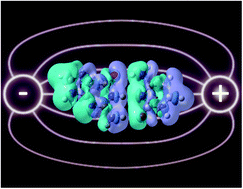 It may be possible to selectively mutate DNA using electric fields, opening the door for exciting new strategies to tune DNA’s structures.
It may be possible to selectively mutate DNA using electric fields, opening the door for exciting new strategies to tune DNA’s structures.
José Cerón-Carrasco and Denis Jacquemin used density functional theory and second-order Møller–Plesset approaches to investigate the effects of electric fields on the tautomeric equilibria of the guanine–cytosine (GC) base pair. They found that electric fields not only drastically alter the kinetics of these equilibria, but also tune the very mechanism of the proton transfer reactions.
A proton transfer between two bases in DNA causes a modification of the interbase hydrogen-bonding pattern, and may consequently lead to a mutation. It is known that external environmental agents, such as free radicals and ionizing radiation, can alter the natural tautomeric equilibria of bases, but little research has been conducted so far about the effects of an external electric field.
Read more in this HOT PCCP article:
Electric-field induced mutation of DNA: a theoretical investigation of the GC base pair
José P. Cerón-Carrasco and Denis Jacquemin
DOI: 10.1039/C2CP44066K










